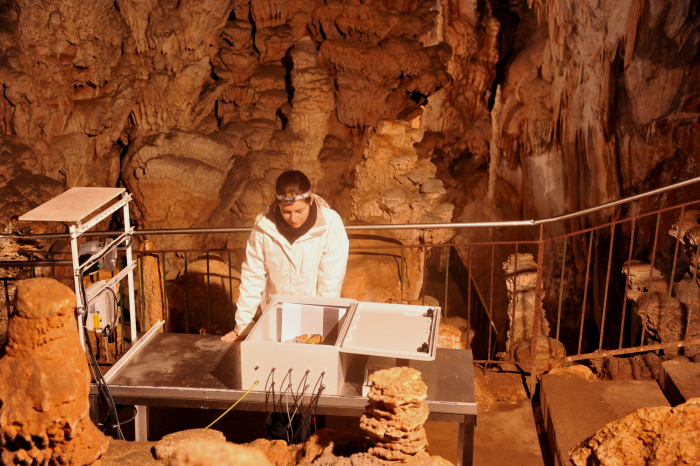



ショーヴェ洞窟の絵画や彫刻は、並外れた芸術的、技術的洗練性を示すだけでなく、知られている中で最も古いもの(360 世紀)でもあります。これらの遺物は壊れやすいにもかかわらず、洞窟の保護された環境の中で完璧に保存されています。この先史時代の洞窟は並外れた関心を集めているため、ユネスコの世界遺産リストに追加されました。
1994 年に洞窟が発見されて以来、洞窟とその外部環境の自然条件を保護するための保護活動が行われてきました。その目的は、洞窟の微気候への影響を制御するために環境条件を継続的に測定しながら、開発と現地訪問を研究に厳密に必要なものに限定することでした。堅牢で正確、高解像度の測定機器を使用することで、信頼性の高い記録データにより、ベンチマークを確立し、自然の変化を監視し、起こり得る気候の変化に注意を払うことができます。
ショーヴェ洞窟の微気候モニタリングは、洞窟内のセンサー システム (温度、気圧、CO2) が CR3000 データロガーにネットワーク接続されて行われます。地上では、Campbell Scientificの気象ステーション (降雨量、気温、気圧センサーを備えた CR1000 データロガー) が外部パラメータを測定します。7 km 離れたアヴァン ドルニャック洞窟には、ショーヴェ洞窟のミラー サイトとして同一の機器が設置されています。データは、地下サイトと気象ステーションの両方で 15 分ごとに同期して記録されます。
こうしたタイプの計測機器により、屋外の気候の変化の影響が多くの洞窟で明確に特定されるようになりました。時間の経過とともに、環境の変化が地下の遺産 (天然の洞窟 (水晶やコンクリーションの洞窟) または文化的な洞窟 (先史時代の装飾洞窟)) の保存にどのように、どの程度影響を与えるかを判断するために、データが完全に評価されます。フランスの他のいくつかの洞窟には、長期研究のために Campbell Scientific の監視機器が装備されています。たとえば、Gouffre d'Esparros では CR6 ベースのシステムが使用され、Marsoulas 洞窟では CR3000 ベースのシステムを使用して監視されています。
洞窟とそれを保護するための保全活動に関する追加情報については、次のサイトをご覧ください。
追加情報は、ScienceDirect にも掲載されています: 「ショーヴェ=ポンダルク洞窟の大気への二酸化炭素流入に対する水文地質学的制御」。概要は公開されていますが、全文を読むにはアカウントまたは支払いが必要です。
ケーススタディの概要
アプリケーション
天然(結晶とコンクリーション)または文化(先史時代の装飾)洞窟での気候測定場所
ヴァロン・ポン・ダルク、アヴァン・ドルニャック、フランス使用製品
CR3000 CR1000 AM16/32B寄稿者
François Bourges, Geology Environment Council参加団体
DRAC Auvergne Rhône-Alpes計測項目
気温、気圧、CO2 、降水量関連ウェブサイト
Geology Environment CouncilPDFで見る